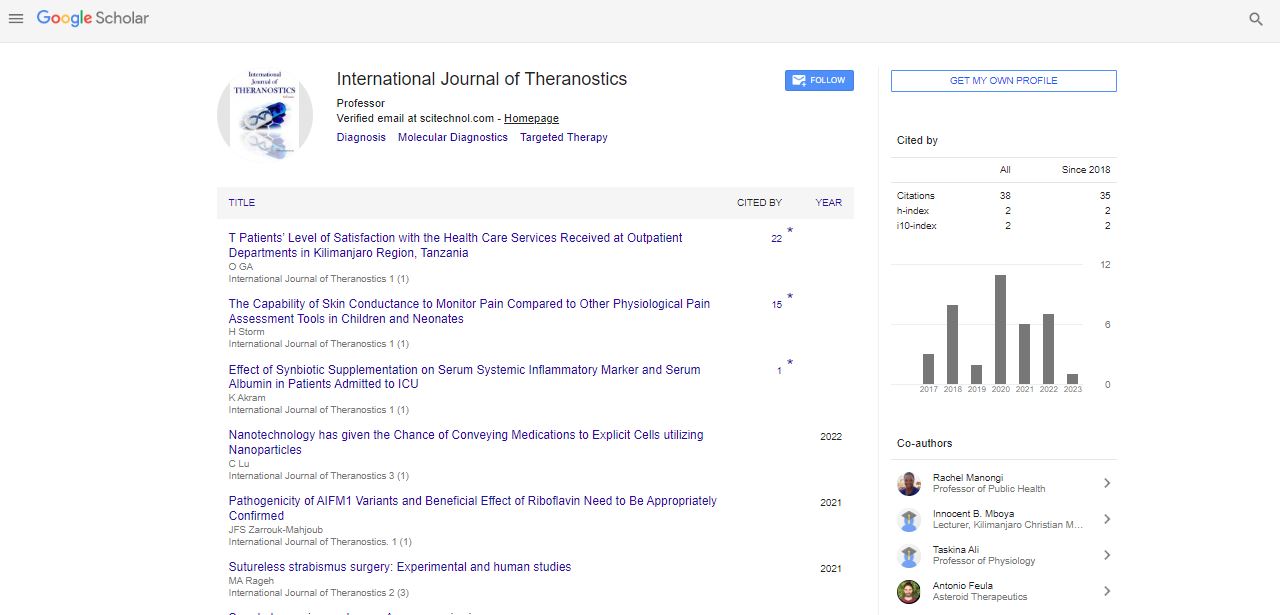Commentary, Int J Theranostics Vol: 3 Issue: 2
Microenvironment Activated Glutathione Self-Depletion Theranostic Nanocapsules
Yu Kyoung*
Department of Pharmacy and Research Institute of Pharmaceutical Sciences, Seoul National University, Seoul, Korea
*Corresponding Author: Yu Kyoung
Department of Pharmacy and Research Institute of Pharmaceutical Sciences, Seoul National University, Seoul, Korea
E-mail: kyoung_yu@.ac.kr
Received date: 07 March, 2022; Manuscript No. IJT-22-56271;
Editor assigned date: 09 March, 2022; PreQC No. IJT-22-56271 (PQ);
Reviewed date: 21 March, 2022; QC No. IJT-22-56271;
Revised date: 31 March, 2022; Manuscript No. IJT-22-56271 (R);
Published date: 08 April, 2022; DOI:10.4172/Ijt.1000110
Citation: Kyoung Y (2022) Microenvironment Activated Glutathione Self-Depletion Theranostic Nanocapsules. Int J Theranostics 3:2.
Keywords: Theranostics
Description
Nuclear Magnetic Resonance (NMR) is an important tool for the explication of chemical structure and chiral recognition. In the last decade, the number of examinations, media, and trials to dissect chiral surroundings has fleetly increased. The evaluation of chiral motes and systems has come a routine task in nearly all NMR laboratories allowing for the determination of molecular connectivity and the construction of spatial connections. Among the features that ameliorate the chiral recognition capacities by NMR is the operation of different capitals. The simplicity of the multinuclear NMR gamut relative to 1H, the minimum influence of the experimental conditions, and the larger shift dissipation make these capitals especially suitable for NMR analysis. Herein, the recent advances in multinuclear (19F, 31P, 13C and 77Se) NMR spectroscopy for chiral recognition of organic composites are presented. The review describes new chiral derevatizing agents and chiral solvating agents used for stereo demarcation and the assignment of the absolute configuration of small organic composites Stereoisomers are composites with the same molecular formula, enjoying identical bond connectivity but different exposures of their tittles in space. Enantiomers are stereoisomers that are glass images of each other but at the same time aren't superimposable. Chirality is important in chemical, physical, pharmaceutical, and natural systems, inspiring new bio mimicrygrounded innovations. Moreover the need to distinguish between enantiomers and quantify Enantiomer Redundant (ER) is of extreme significance in the pharmaceutical assiduity and for asymmetric conflation.
Currently the use of chromatography separation of enantiomers on chiral stationary phases is still the approach most frequently applied in ultramodern chemical exploration. Still, the hunt for new chiral discriminating procedures that allow for quick analysis, high resolution, and mileage for numerous non-volatile or thermally unstable composites is adding. Among the several stereo demarcation styles, including X-ray, indirect dichroic, luminescence spectroscopy, and electrophoresis, Nuclear Magnetic Resonance(NMR) spectroscopy continues to be a useful tool for determining the enantiomer chastity and assigning the absolute configuration of chiral motes.
NMR active capitals are isochronous in an achiral medium and don't permit their demarcation, but in a chiral terrain these capitals are an isochronous and chiral demarcation is possible.
Thus to perform the enantiopurity analysis, a chiral derivatization or solvating agent is essential to produce anon-equivalent diastereomeric admixture and applicable differences in the NMR gamut. Chiral reprivatizing agents form a covalent bond with a reactive half of the substrate and chiral solvating agents associate with the substrate through non-covalent relations, similar as dipole–dipole and ion pairing. In this environment, strategies grounded on different intermolecular relativities, relations and packing orders for a brace of enantiomers are in constant development.
X-ray Scattering
The use of 1H NMR spectroscopy to dissect the number-average molecular weight of a methyl poly (ethylene glycol) and an acetate outgrowth of this MPEG is described. These analyses illustrate NMR principles associated with the chemical shift differences of protons in different surroundings, NMR integration, and the effect of the natural cornucopia of 13C imitations in a polymer and the performing low but predictable intensity of the satellite peaks due to 13C–1H spin–spin coupling. Also included in this discussion is an illustration of endgroup analysis of the product of an acetylation response. In the discussion of the acetylation product, a 1H NMR diapason of a crude product admixture where the small peaks due to end groups can be seen along with a set of contaminations due to catalyst, detergents, and derivations is included because, in practice, druggists frequently first see these feathers of gamut. We showcase the high eventuality of the2′-Cyano Ethyl Methyl (CEM) methodology to synthesize RNAs with naturally being modified remainders carrying Stable Isotope (SI) markers for NMR spectroscopic operations. The system was applied to synthesize RNAs with sizes ranging between 60 to 80 nucleotides. The presented approach gives the possibility to widely modify larger RNAs (>60nucleotides) with snippet-specifically 13C/15N-labelled structure blocks. The system harbors the unique eventuality to address structural as well as dynamic features of these RNAs with NMR spectroscopy but also using other biophysical styles, similar as Mass Spectrometry (MS) or Small Angle Neutron/X-Ray Scattering (SANS, SAXS).
Phosphoramidites
Result and solid state Nuclear Magnetic Resonance (NMR) spectroscopy have proven to be largely suitable to address structural and dynamic features of RNA. A prerequisite to apply state-of-the-art NMR trials is the preface of a Stable Isotope (SI) labeling pattern using 13C/15N labeled RNA or DNA precursors. The most widespread system uses labeled (2′-deoxy)-rib nucleotide triphosphates and enzymes to produce the asked RNA or DNA sequence amended with 13C and 15N capitals. This approach enables to produce sufficient quantities of RNA and DNA for NMR spectroscopic operations. This well-established system allows nucleotide specific labeling by mixing a SI-labeled with unlabeled d/r NTPs. Especially in larger RNAs (60nt) similar nucleotide specific SI-labeling can still lead to significant resonance imbrication. That's why, the PLOR (positionpicky labeling of RNA) system was lately introduced, which holds the pledge to point- specifically marker RNA using SI-labeled rib nucleotide triphosphates and T7 RNA polymerase.
 Spanish
Spanish  Chinese
Chinese  Russian
Russian  German
German  French
French  Japanese
Japanese  Portuguese
Portuguese  Hindi
Hindi 